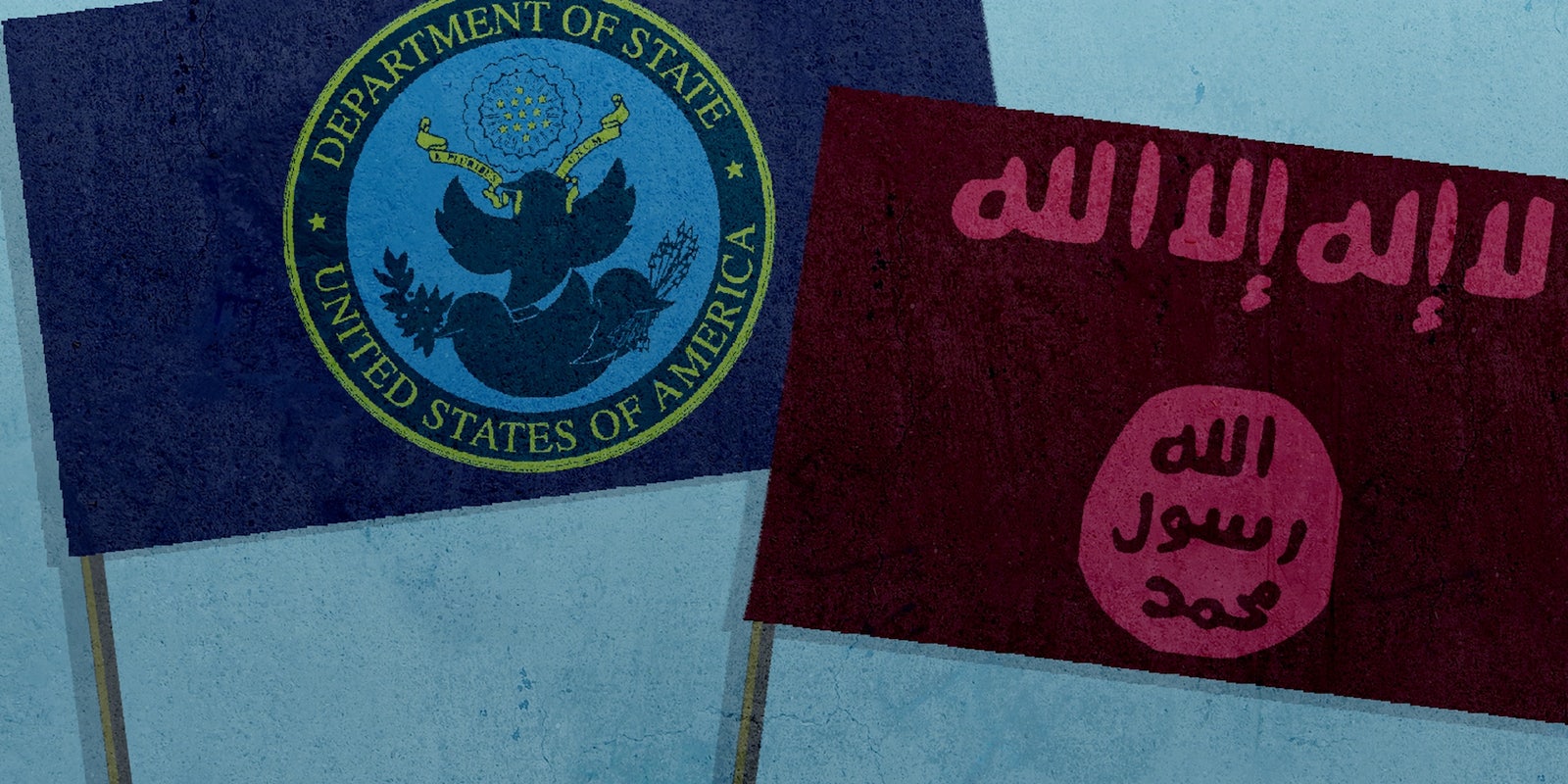The U.S. government has been unable to fight the Islamic State in Iraq and Syria (ISIS) on the one battlefield it currently commands: the Internet. For proof, look no further than the U.S. State Department’s August 2014 “Welcome to ‘Islamic State’ Land” YouTube video, a counterterrorism blunder nearly as inexcusable as the flawed intelligence reports that led to the 2003 invasion of Iraq.
In an attempt to combat ISIS’s slick multimedia campaign extolling the virtues of its so-called caliphate, the U.S. government combined graphic images of ISIS’s prisoner beheadings, statue demolitions, and other war crimes with text that taunted the group and its aims. “Travel is inexpensive,” the video proclaims in white text on a black background proclaimed, followed by a clip of ISIS fighters driving a convoy, “…because you won’t need a return ticket!” The footage switches to dead jihadists’ bodies strewn across the ground.
https://www.youtube.com/watch?v=-wmdEFvsY0E
Western media outlets pounced on the video after it spread on Twitter. John Oliver mocked it mercilessly on his HBO show Last Week Tonight. “I found it so horrifying that I personally couldn’t watch the whole thing,” Christina Schori Liang, a senior fellow at the Geneva Center for Security Policy, said of the video.
The Obama administration in early January announced an overhaul of its programs aimed at countering violent extremism (CVE) online. The State Department’s Center for Strategic Counterterrorism Communications (CSCC), which produced the controversial video, was rebranded the Global Engagement Center, and its mission changed from producing content to partnering with local organizations on the ground to develop better messages. The government is also meeting with tech companies to brainstorm new approaches.
“I found it so horrifying that I personally couldn’t watch the whole thing.”
But the legacy of the video lingers in the minds of people who study and combat violent extremism online. Liang and other experts interviewed for this story described current efforts to create online “counter-narratives” to ISIS propaganda as woefully underfunded, counter-productive, and ignorant of the basic principles—from psychology and spirituality to customization and virality—that ISIS is exploiting to gain the edge in this digital war.
To experts in this field, “Welcome to the ‘Islamic State’ land” was the counter-messaging equivalent of “We will be greeted as liberators”: an ominous sign of how poorly prepared the United States was to enter this battlefield.
The ISIS strategy—and why it works
For the Islamic State, social media is as potent a weapon as any captured American tank or rocket launcher. More so than any other terrorist network, ISIS has mastered every element of social media propagandizing. It crafts psychologically canny messages, tailors them to specific audiences, recruits a vast and dedicated network of distributors, and exploits the natural virality of social networks to amplify its call to jihad.
To put it simply, ISIS gets the Internet and its audience in a way the U.S. government does not.
ISIS’s messages target people by preying on two psychological factors. The first is what Alejandro Beutel, a researcher at the University of Maryland’s National Consortium for the Study of Terrorism and Responses to Terrorism, called “cognitive closure,” or “a quest for certainty.” Young Muslims living in Western countries like the United States often feel pulled between their nationality and their religion—especially at times of heightened Islamophobia generated by the anxiety that follows terrorist attacks. “Many of these young individuals,” Beutel said, “are dealing with dual identities and trying to figure out how they can blend them together.”
Young Muslims who feel torn between what can seem like two different worlds, who long for structure and meaning in their lives, are ISIS’s best targets. They seek a coherent picture of the world—and ISIS is ready to offer one. Imagine being 19 years old, living in a major American city, and not understanding how a terrorist attack in Paris can change the way your fellow subway passengers look at you. If that prejudice or bigotry mystified you, you might gravitate toward someone offering an explanation that felt like it fit with your experiences. You might start watching YouTube videos about the supposedly irreconcilable differences between the West and the Islamic world. ISIS shapes its content to appeal to this person and others who lack a framework for understanding world events and are willing to embrace a radical one.
“They’re tapping this kind of moment in youth where you feel like there’s nothing going and you need a new adventure, you need a new thing.”
The other psychological factor that ISIS exploits is the natural desire for purpose. ISIS is a bonafide regional power, and to people who already feel out of place in Western society and crave a sense of direction, joining ISIS offers that purpose, that significance. They can become part of something bigger than themselves. They can fight for a cause. ISIS’s messages don’t just offer a framework for understanding the world; they also offer the chance to help shape it. These messages “make people feel like they matter in the world,” Beutel said, by promising “a sense of honor and self-esteem, and the ability to actively live out those desires.”
There are also more pragmatic promises, tailored to people who are not only spiritually aimless but economically frustrated and emotionally unfulfilled. Liang described this part of the appeal as, “Come and you will have a real life. You will have a salary. You will have a job. You will have a wife. You will have a house.”
“This is appealing to people who have, really, no future,” she said.
Then there’s the simple restlessness of young people—a factor policymakers dismiss at their peril. “They’re tapping this kind of moment in youth where you feel like there’s nothing going and you need a new adventure, you need a new thing,” Liang said.
For youth in nearby Muslim countries wracked by civil war, ISIS gives their chaotic lives stability and a higher calling in a society that puts religious meaning above all else. “For these young people, they send this idea of this sanctity of the caliphate,” Liang added. “This gives it, to religious youth, a real call to come to the caliphate. It gives them real purpose.” Religion is a key part of that purpose. ISIS argues that “this is an indisputable battle between the Shia and the Sunni,” Liang said, “and in order to protect your own Sunnis, you have to come and help fight this war. They really have a black-and-white … way they paint it. You really have no choice. You have to come.”
It’s not just about religion. Restless young people are also often full of anger, the result of years of slights real or imagined, and ISIS is ready to tell them that whatever anger they feel is really part of its broader struggle. Peter Romaniuk, an associate professor of political science at the City University of New York’s John Jay College of Criminal Justice, said that ISIS’s modus operandi was to “give people every opportunity to frame their grievances in a way that accords with ISIS’s message.”
The U.S. government is aware of this phenomenon. In remarks at Chatham House in London, on Jan. 18, Richard Stengel, the under secretary of state for public diplomacy and public affairs, observed that ISIS was “exploiting a vast market of grievance, of unhappiness, of unemployment, of lack of meaning.”
“They’re not creating a market; they’re exploiting a market,” Stengel said. “And what you know from advertising is … it’s much easier to exploit a market than to create one.”
By exploiting its audience’s psyche, ISIS is not unlike a sophisticated political campaign. And like high-stakes electoral efforts aimed at diverse audiences, ISIS knows how to tweak its rhetoric and imagery to suit every demographic group.
“They have a special, unique message for young girls,” Liang said. “They have a special, unique message for drug addicts, for ex-cons. They have a special, unique message for ex-combatants in Chechnya. They really tailor their approach to each region and to each specific need.”
Farah Pandith, an adjunct senior fellow at the Council on Foreign Relations and former official in the Bush and Obama administrations, compared this customization to Internet marketing. “They learn what’s working, they take away what isn’t,” she said, “and they are developing—as any marketer … or any advertiser would do—a way to appeal to the millennial generation that makes sense for them.”
In a sign of just how potent ISIS’s message is, researchers estimate that the vast majority of the people disseminating pro-extremist content are not even members of the group but simply fans of its work. This is the key to its successful distribution model.
“Ninety percent of ISIS Twitter messages are put out by their cheerleaders and by their supporters, not actual formal ISIS members,” said Buetel. “These are people who volunteer their time, but the thing is, they volunteer copious amounts of their time, and they make it their singular focus. And when you crowdsource it, it creates this sort of voluminous effect.”
Shannon Green, the director of the Center for Strategic and International Studies’s Human Rights Initiative, calls these people “fanboys.” They are ISIS’s perfect messengers because their lack of formal association with the group enhances their credibility. It’s the equivalent of the way that a Toyota owner has more credibility than a Toyota dealership manager in recommending one of the company’s cars. You’re more likely to trust someone who isn’t on the payroll.
ISIS does pay some of its recruiters, according to Liang. “And these recruiters, they’re even cynical,” she said. “They know that half the stuff they’re telling people online is hogwash. They’re cynically attracting young people, because they know that they’re going to get a salary from [ISIS] for doing this. It’s a job.” By combining the benefits of both approaches, ISIS imitates the tactics of successful presidential campaigns, which depend on both paid advertising and “earned advertising,” the free exposure that their messages get from journalists reporting on their ads.
Whether they’re cynical Internet contractors or committed fanboys, ISIS propagandists spread their messages by exploiting two inescapable aspects of social media: virality and echo chambers. Their reliance on virality often leads to jarring tweets, as they combine videos of beheadings with trending hashtags. Beutel has seen ISIS messengers tag extremist content with the hashtags for major soccer matches. They also incorporate memes and current events into their posts. “When something happens in real life,” Pandith said, “they’re grabbing stills and images [from news footage], so that people feel like they’re keeping up with them.”
“Ninety percent of ISIS Twitter messages are put out by their cheerleaders and by their supporters, not actual formal ISIS members.”
Even more pernicious, from the perspective of CVE specialists trying to guide people away from radicalization, is ISIS’s use of the echo-chamber effect, wherein the perception of solidarity and community reinforces the strength of the message. One of ISIS’s favorite terms for those who dwell in its echo chamber is “baqiyah bros.” The word “baqiyah” comes from the ISIS slogan “baqiya wa tatamaddad,” which roughly translates to “remaining and expanding” or “enduring and expanding”—a defiant tone for a besieged insurgency that seeks legitimacy and permanence.
“‘We are the bros that are enduring,’” Beutel said, translating the term. “We’re a bunch of bros that are hanging out together, having this online community, but we’re also having this sense of purpose here—that we are enduring, we are a community that is here to stay, and we are a community that is serving this higher purpose as well. … It plays on these psychological mechanisms, creating this echo chamber that’s reinforcing these messages, and creating a sense of community that is also an additional incentive to engaging in these extremist clicks, if you will.”
Why counter-narratives aren’t working
The War on Terror is self-perpetuating. From drone strikes to support for Israel, Western governments’ policies have either hurt or offended the people contemplating joining a jihadist group. These governments cannot prevent people from being radicalized, because it is their actions that spurred the radicalization in the first place.
“The U.S. Government, any government, is not necessarily the best messenger for the message we want to get out there,” Stengel, the State Department public-affairs official, said in his Chatham House remarks. “In fact, they use us as a recruiting tool. They use our messaging as a recruiting tool.”
In the nearly 15 years since Al Qaeda brought down the Twin Towers, the United States and its allies have spent more money and energy fighting the kinetic war than the ideological war. This approach both takes resources away from anti-extremism propaganda efforts and provides the fodder for the very propaganda ISIS and terrorism organizations use to entice new recruits.
“We haven’t been able to integrate the so-called ‘soft power’ approach hand-in-hand with the ‘hard power’ approach,” said Pandith. “So you see a very precise and very evaluated and very strategic set of goals and missions and plans for hard power. You do not see the same thing in the soft-power arena.”
Given the catch-22 of using military force to combat Islamic extremism, experts say, the U.S. should place firmer limits on its kinetic activities if it hopes to staunch the flow of successful propaganda. “The idea of winning the war of ideas is very mixed into the idea of the superiority of the spirit—the idea that the enemy has to prove that it is better, that is morally better than the existing ruler,” said Liang. “We’re not winning that moral superiority if we’re killing innocents through our kinetic power. We have to find a path in the middle.”
This is a problem of both money and vision, Pandith said. Obviously, funding is crucial. But the other important piece is that it’s unclear, in her words, “who, at the end of the day, understands the whole battlefield in the ideological space?” Right now, the counter-narrative effort—unlike the military campaign in Iraq and Syria—does not feel cohesive.
“Those people that are in favor of terrorism, extremism, dedicate all day, every day to very enthusiastically spreading those messages,” said Ross Frenett, the co-founder of Moonshot CVE. “On the other side, you have a mixed bag.”
Another problem is that anti-ISIS efforts are not carefully targeted. “We tend to post something on a YouTube channel, for example, or on a Facebook account and expect people to come to us,” Green said, “versus being really proactive in trying to use data analytics to identify the target audience and then find really creative ways of putting that information in front of them.”
How counter narratives are transmitted is only one of the big distribution problems. The other is who is doing the transmitting. For the most part, right now, it is Western governments—and governments are not agile enough to effectively engage in the digital space. Beutel pointed out that government contractors or employees are often slow to respond to extremist content with counter-messaging because their work must be passed up a bureaucratic chain for approval. “If someone posts, for example, a question on a Facebook group which is trying to counter ISIS, they need to be responded to and engaged with very quickly,” he said. “And sometimes the layers of approval the government needs to go through would mean that … by the time something goes up on the page, it’s a week later, and the individual involved has moved on.”
The State Department has tried engaging with extremists and their potential converts through its “Think Again, Turn Away” campaign, which produced that inflammatory “Welcome to the Islamic State” video. On its Facebook and Twitter pages, the government crows about ISIS’s “battlefield setbacks” and points out would-be suicide bombers who change their minds. It is intended to expose the folly of ISIS’s tactics and ideology, making both a moral and pragmatic argument against the insurgency. But it has been roundly criticized as ineffective and inflammatory. Beutel called it “a dismal failure” and an example of the fact that governments “have no resonance with these kinds of things.”
“What we know is that Muslim youth need to hear the counter-messages from their peers, and people that they trust, and people that are cool, and people that are role models and are what we call credible voices,” said Pandith. “Even a government of a Muslim-majority country isn’t a credible voice to young millennials. They just aren’t.” But it can be difficult to find voices who would be credible to potential jihadists, because the people managing these programs often have no ability to relate to those potential jihadists. “Having somebody craft the messages who really understands where someone is coming from is so important,” said Green. “What you or I may think will resonate with someone just doesn’t if you really can’t understand the mentality.”
Counter-narratives have also been poorly designed by people who don’t understand the mentality of ISIS and its adherents. The “Welcome to the Islamic State” video best exemplifies this problem. “They tried to meet violence with violence,” Liang said of the video. “They’re trying to basically … make it so violent that they get the people that want to watch the violent stuff. … But they’re sort of stooping down to [ISIS’s] level, which I find really sort of tragic.”
A former senior Obama administration official, who requested anonymity to describe internal government deliberations, described the video was “on many levels, a mismatch,” saying that it would only reach “a very small segment of ISIS supporters” who were “interested in and attracted by the brutality.” The official bemoaned the fact that “some of the snarky messaging that was meant to be satire and was meant to mock ISIS” did not “land in the way that people anticipated.”
“ISIS is not selling itself based on its brutality,” the official said. “It’s selling itself based on the fact that it can provide a sense of purpose and belonging and meaning to people who otherwise feel like they’re unmoored and neglected by society. So if that’s the thing that’s attracting a certain segment of the people, then you need to engage in messaging that’s going to be providing people with other meaningful opportunities, and a sense of purpose and identity and belonging.”
U.S. counter-narrative production has also tended to follow a one-size-fits-all approach, in contrast to the Islamic State’s sophisticated, demographically targeted propaganda operation. Pandith said that this has hindered efforts to reach people whose grievances and concerns fall outside of the narrow pitch that counter-narrative messengers are pursuing. “If you’re fighting an ideology, you have to use a very careful approach to understand the local climate in which you’re partnering with local organizations on the ground,” she said. “You have to understand that the nuance matters.”
When these anti-ISIS messages aren’t satirizing the jihadist group, they are crudely and counter-productively scolding its followers and potential followers. “There’s very often a temptation,” Frenett said, “to have finger-waving counter-narratives rather than ones which are genuinely engaging.” Community groups are guilty of this too, he said. Some of them “think the best way of going about creating a counter-narrative is to stick a camera in a grey-bearded imam’s face and have him talk to the camera for 20 minutes or half an hour.” In theory, a local voice would be more convincing, but this imam’s lecture probably wouldn’t do much good, because, as Frenett noted, “If the young men and women that are joining ISIS were listening to their imams in the first place, this wouldn’t be a problem.”
Bad counter-narratives—whether overly snarky, like the CSCC video, or simply tone-deaf in other ways—can stigmatize the very people they’re intended to reassure and persuade. In September 2015, Romaniuk published a paper analyzing 27 CVE program evaluations. Among his various observations was that poorly thought-out CVE programs often left counterproductive impressions on the recipients of the messages. He cited a 2011 evaluation of the United Kingdom’s “Prevent” program, which noted that past efforts had “given the impression that Muslim communities as a whole are more ‘vulnerable’ to radicalisation than other faith or ethnic groups.”
Evaluators of another British program noted that staff members avoided the term “preventing violent extremism” because they believed that “young people, families, and communities would all feel that ‘PVE’ implied that they personally either supported such extremism, or were at risk from it, so providing a highly negative starting point.”
“Those evaluations,” Romaniuk said, “did show that the recipients of CVE programming sometimes felt stigmatized by the fact that they were recipients of CVE programming.”
Given all of the problems with the State Department’s work, why didn’t the National Security Council, which oversees government-wide foreign-policy operations from the White House, intercede to stop the CSCC earlier? Part of the problem is that, according to the senior administration official, the NSC didn’t approve each of the CSCC’s messages. “For a very brief period of time when CSCC was piloting their English-language effort, the NSC would lead an interagency approval process,” the official said. “But [the program] didn’t go through NSC clearance per se.”
The NSC, which includes representatives from the major cabinet departments and intelligence agencies, did hold meetings to try to “unpack and understand” ISIS’s messaging strategy and viral appeal. In those meetings, policymakers recognized the need to contrast ISIS’s utopian claims and the less rosy reality. But, the official said with a laugh, “You have to understand that some of the people who were creating those messages were not necessarily involved or at the table when those more strategic policy conversations were happening.”
Looking back, the official said, “I think the NSC maybe could have set the tone a little bit better in terms of the focus of the messages.”
Green is intimately familiar with this issue. While at the NSC, she helped organize the February 2015 White House Summit on Countering Violent Extremism. One of her tasks was inviting civil-society organizations working on counter-narratives to attend the summit and share their experiences. Not only were many groups interested in participating, but many of them approached her afterward with creative CVE proposals that built on the enthusiasm generated at the summit. But the funding ultimately wasn’t there.
“People were inspired and they wanted to do something, but there wasn’t some ready-made pot of money that we could use to support those efforts,” Green said. “That was my frustration: the mismatch between getting people really excited and then what we actually had at our disposal to follow through.”
How to improve counter-messaging
If the U.S. and its allies want to dissuade would-be jihadists from joining ISIS, they need to start from square one. “We need a compelling story that makes our story better than theirs,” Liang said. “And so far their story is trumping ours.”
The anti-extremist story can’t just be a paean to human rights and liberal democratic values. It must provide clear promises about what the Middle East will look like if ISIS is defeated. “What are we going to do if we take back the land that [ISIS] is inhabiting at the moment?” Liang said. “What government are we going to set up, and how legitimate will it be? If you look at, right now, the Iraqi state, it’s extremely corrupt, and it has to prove that it will be the better alternative.”
Part of the challenge that counter-narrative designers face is that the anti-extremist story can’t just be a sweeping theoretical message. It has to be pragmatic, full of real promises. But no one has a clear idea of how to do this. “To be totally honest, we haven’t cracked that nut yet,” the former senior administration official said. “Maybe it is liberal values and a democratic order and human rights and democratic values. I would hope that that would be the case. But I don’t think that there’s evidence yet that that would be equally compelling as a narrative or a set of values.
“Everyone agrees [that] we can’t just counter-message,” the official added. “We have to promote alternative messages. But nobody understands or agrees or has the answer in terms of what are the alternate courses of action or pathways that one could offer.”
While the big-picture thinkers devise a story, others should focus on a bevy of vital changes to how counter-narratives are produced and distributed. For one thing, the content is too grim. Instead of going dark, Beutel said, go light: Offer would-be jihadists hope. Humanize ISIS’s foot soldiers instead of demonizing them, so that your intended audience understands that you care about their fate and not just taking them off the battlefield. “When you have people who are espousing incredibly hateful worldviews, the tendency is to want to demonize them—to want to shut them out [in order] to isolate them,” Beutel said. “More often than not, that actually repulses people rather than [getting] them to open up.”
Frenett has seen firsthand that offering people hope can work. He participated in a pilot project testing this approach, and the results were encouraging. “We had a team of former extremists reach out to these individuals if they were doing things like, for example, openly promoting ISIS, openly promoting [ISIS leader Abu Bakr] al-Baghdadi,” Frenett said. “When they messaged them saying, ‘ISIS is terrible, they’re doing this and this, do you realize what’s going on?’ they tended to get very low response rates.” But when the former extremists launched conversations with budding jihadists on positive terms, more people responded, and those conversations went better.
“When we try and intervene directly with potential extremists online,” Frenett said, “that positive messaging can also be quite effective.”
It is vital to recruit former jihadists—who know better than anyone else what the world of ISIS is like—to reach out to would-be extremists and relay their experiences. “They can empathize in a way that others can’t,” Green said. Not only are former jihadists more likely to pierce that initial wall of skepticism, but their ability to say “I’ve been where you’ve been” gives their words more power.
Counter-messaging must also emphasize the futility of ISIS’s regional ambitions. As has been noted, the group derives much of its appeal from a combination of religious prophecy (the coming of an apocalyptic event) and material stability (the promise of a steady job and all the benefits that accrue from that). But the group isn’t close to achieving its goals, and anti-extremist messages need to point that out. “Insofar as ISIS can continue to show that they have momentum and that they’re the victors, people will be attracted to joining them, because people want to be associated with a winning cause,” the former senior administration official said. “I think the administration, particularly [the Department of Defense], has tried to show more evidence that [ISIS is] on their back foot.”
There are already some programs designed to improve the quality of the counter-messages that CVE efforts produce. The University of Maryland hosts a National Consortium for the Study of Terrorism and Responses to Terrorism (START) that offers CVE fellowships. A Dubai-based group called Hedayah hosts workshops bringing together private companies and civil-society organizations. These programs offer a starting point for future efforts. “It’s just that those things need to be scaled up,” Green said, “and they need to be much more sustainable.”
Even a great message is nothing without a sophisticated distribution plan. Anti-extremist messengers will need to learn more about the places where budding jihadists congregate, including which ISIS propagandists are influential, in what ways, and to whom. With their massive databases of user information and carefully refined analytical tools for processing data, tech companies are well-positioned to help here. Google, Beutel said, could help “map out [ISIS’s] social networks and then begin to identify the key nodes of people who produce these messages and develop different messaging strategies.”
Tech companies can also leverage their understanding of how messages spread to post anti-extremist advertising campaigns in ways that they know will resonate best. Google is already doing this in the United Kingdom, putting links to counter-narratives in the search results for queries like “join ISIS.” Twitter, perhaps ISIS’s favorite platform, is partnering with NGOs “to empower credible non-governmental voices against violent extremism.” Social networks can also whitelist government accounts to stop terrorists from fraudulently reporting them as abusive, a tactic that ISIS once used to bring down the “Think Again, Turn Away” campaign’s Twitter account. “Technology companies have been more and more engaged with nonprofits and with governments to produce positive material to place on their platforms,” said Frenett, “partly so they can defend against calls for greater censorship.”
Local governments, trusted religious and cultural figures, and respected nongovernmental organizations are also crucial allies in CVE efforts, and the State Department’s Global Engagement Center is actively pursuing such partnerships.“You have to have [help from] civil society, that is independent of any influence from the state, to be able to take on those kinds of things,” Beutel said. “They have the most potential to know their audience.” Religious leaders like imams may have enough “scholarly cred,” as Beutel put it, to overpower the words of someone on the Internet urging the target to follow a radical path.
Local governments, imams, and NGOs also have a freer hand in how they engage with would-be extremists, because they can criticize Western governments’ policies on issues like drone strikes and foreign aid for Israel in order to build a rapport. “That ability and willingness to share some ground with these people that are disaffected is something that makes a huge difference,” Frenett said.
But these local actors’ independence can be a double-edged sword for governments planning CVE work. Not only does trusting them mean giving up control of the message, but these people and groups might have their own controversial pasts. “There are religious leaders, like Imam Suhaib Webb, who have a really significant following with young people and are very credible,” Green said. But the U.S. would risk fierce criticism from some of its allies if it partnered with people like Webb, “because there are some controversies around what he and others have said and stances they’ve taken on certain foreign-policy issues.” Embracing someone who sharply criticizes Israel, for example, can be just as controversial as issuing the criticism directly.
As the State Department moves toward the new approach embodied by the Global Engagement Center, experts said, it should be mindful of what governments are still well-suited to doing in the CVE space. Frenett stressed the importance of giving former extremists and other credible voices the tools to engage in a space that may be new to them—especially if they’re members of an older generation. “Very credible individuals,” he said, “don’t necessarily have the kind of social-media expertise of the millennial generation that they’re trying to counter.”
Experts praised the GEC’s new focus on local partnerships, but they warned of risks beyond the potential for an imam to say something controversial. For one thing, if the State Department funds a campaign, it must be careful not to endanger the autonomy or credibility of its local partner. “Whoever’s leading the charge on this effort to collaborate with local partners,” Pandith said, “is going to have to do it in a way that the localized partners on the ground globally feel as though they have the right to produce the content—that there is no structure that the U.S. government is telling them what to say.”
It is unclear exactly how much of a propaganda coup it would be for ISIS to link a local CVE effort to the West. On the one hand, to people who have been steeped in ISIS messages about Western corruption, the discovery that the State Department is paying your imam to criticize ISIS “reinforces the extremist narrative of some kind of conspiracy or discrimination,” Romaniuk said. But as Frenett pointed out, ISIS is fond of labeling every CVE campaign “the work of Zionists,” and that message may not resonate as deeply outside its core flock. “Your hardened ISIS [militant] isn’t necessarily your audience,” he said. “Your audience is that person that’s considering moving over to that side. To that audience in particular, it’ll make a huge difference that there’s not a State Department logo at the end of those videos.”
“The song will keep living on”
On Feb. 16, Deputy Secretary of State Tony Blinken delivered a speech entitled “New Frameworks for Countering Terrorism and Violent Extremism” at the Brookings Institution in Washington. “We are expanding partnerships to develop the expertise to better understand violent extremism and its drivers at the international, regional, national, and local levels,” Blinken said. “We are developing the research and evidence base to shape rigorous and targeted initiatives tailor-made to the communities in which they will be implemented.”
Blinken did not mention the problem that Liang identified as the core of the U.S. government’s failures up to this point: the absence of a compelling story. Civil-society organizations, tech companies, and local religious leaders can provide all the insight and expertise that they have to offer, but that wisdom will be useless without a story to contrast with ISIS’s message of glorious, spiritually fulfilling jihad.
It’s unclear, in fact, whether creating a single, unified story is even on the agenda. The former senior administration official said that the National Security Council, which oversees interagency CVE work, now has a better understanding of what worked and what didn’t in counter-messaging. “They have more people on staff who are looking at the intelligence and understanding the messages,” the official said. “I think it’s gotten better.”
The next step will be even harder. Once the anti-ISIS messengers develop a compelling story, they will have to confront a sobering reality: 15 years of targeted killings, drone strikes, and Special Forces raids have created general mistrust and Middle Eastern turmoil. Just killing terrorists isn’t enough. Eventually, the U.S. and its allies will need to start persuading potential terrorists to rethink their lives.
“We’re spending billions on the kinetic war, trying to kill the singers,” Liang said, “but the song will keep living on.”
Illustration by Max Fleishman








